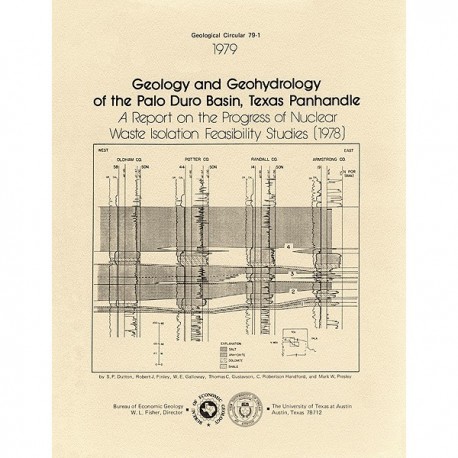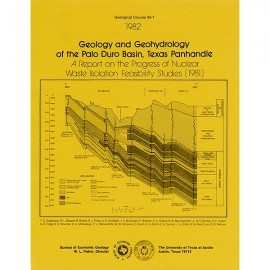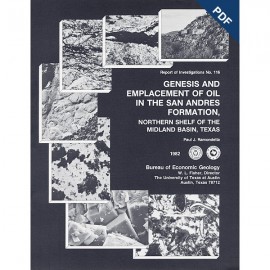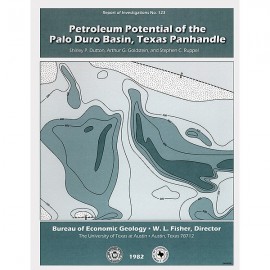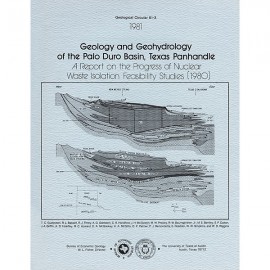Geological Circulars
-
Books & Reports
- Reports of Investigations
- Guidebooks
- Udden Series
- Geological Circulars
- Down To Earth
- Atlases of Major Oil and Gas Reservoirs
- Texas Memorial Museum Publications
- Environmental Geologic Atlas of the Texas Coastal Zone
- Mineral Resource Circulars
- Other Reports
- Seminars and Workshops
- Handbooks
- Submerged Lands of Texas
- Symposia
- Annual Reports
- Open File Reports
-
Maps & Cross Sections
- Thematic Maps
- Miscellaneous Maps, Charts & Sections
- Geologic Atlas of Texas
- STATEMAP Project Maps
- Geologic Quadrangle Maps
- Cross Sections
- Highway Geology Map
- Energy and Mineral Resource Maps
- Shoreline Change and Other Posters
- Wilcox Group, East Texas, Geological / Hydrological Folios
- Bouguer Gravity Atlas of Texas
- River Basin Regional Studies
- Featured Maps
- Posters
- Teachers & the Public
-
Geological Society Publications
- Gulf Coast Association of Geological Societies
- Alabama Geological Society
- Austin Geological Society
- Corpus Christi Geological Society
- Houston Geological Society
- Lafayette Geological Society
- Mississippi Geological Society
- New Orleans Geological Society
- South Texas Geological Society
- GCS SEPM Publications
- Historic BEG & UT Series
Geology and Geohydrology of the Palo Duro Basin, Texas Panhandle...(1978)
GC7901
A free, digital version of this publication can be found on: Texas ScholarWorks
GC7901. Geology and Geohydrology of the Palo Duro Basin, Texas Panhandle: A Report on the Progress of Nuclear Waste Isolation Feasibility Studies (1978), by S. P. Dutton, R. J. Finley, W. E. Galloway, T. C. Gustavson, C. R. Handford, and M. W. Presley. 99 p., 62 figs., 6 tables, 1979. ISSN: 0082-3309. Print.
To purchase this publication as a PDF download, please order GC7901D.
ABSTRACT
Integrated, detailed, and comprehensive study of the physical stratigraphy, tectonic history, hydrogeology, geomorphology, and resource potential of the Palo Duro and Dalhart Basins, Texas Panhandle, is part of a national evaluation of ancient salt basins as potential sites for isolation and management of nuclear wastes.
Early in 1977 the Bureau of Economic Geology was invited to assemble and evaluate geologic data on several salt-bearing basins within the State of Texas as a contribution to the national nuclear repository program. In response to this request, the Bureau, acting as a technical research unit of The University of Texas at Austin and the State of Texas, initiated a long-term program to assemble and interpret all geologic and hydrologic information necessary for delineation, description, and evaluation of salt-bearing strata in the Panhandle area. The technical program can be subdivided into three broad research tasks, which are addressed by a basin analysis group, a surface studies group, and a basin geohydrology group. The basin analysis group has assembled the regional stratigraphic and structural framework of the total basin fill, initiated evaluation of natural resources, and selected stratigraphic core sites for sampling the salt and associated beds. Two drilling sites have provided nearly 8,000 feet (2,400 m) of core material for analysis and testing of the various lithologies overlying and interbedded with salt units. Concurrently, the surface studies group has collected ground and remotely sensed data to describe surficial processes, including carbonate and evaporate solution, geomorphic evolution, and fracture system development. The newly formed basin geohydrology group will evaluate both shallow and deep circulation of fluids within the basins. This paper, a summary report of progress, reviews principal conclusions and illustrates the methodologies used and the types of data and displays generated. Several topical reports will be forthcoming as phases of the study are completed and will discuss in detail various geological aspects of the Palo Duro and Dalhart Basins.
Keywords: Dalhart Basin, geohydrology, waste isolation, stratigraphy, tectonic history, hydrogeology, geomorphology, resource potential, Palo Duro Basin, Panhandle, Texas
Citation
Dutton, S. P., Finley, R. J., Galloway, W. E., Gustavson, T. C., Handford, C. R., and Presley, M. W., 1979, Geology and Geohydrology of the Palo Duro Basin, Texas Panhandle: A Report on the Progress of Nuclear Waste Isolation Feasibility Studies (1978): The University of Texas at Austin, Bureau of Economic Geology Geological Circular 79-1, 99 p.
